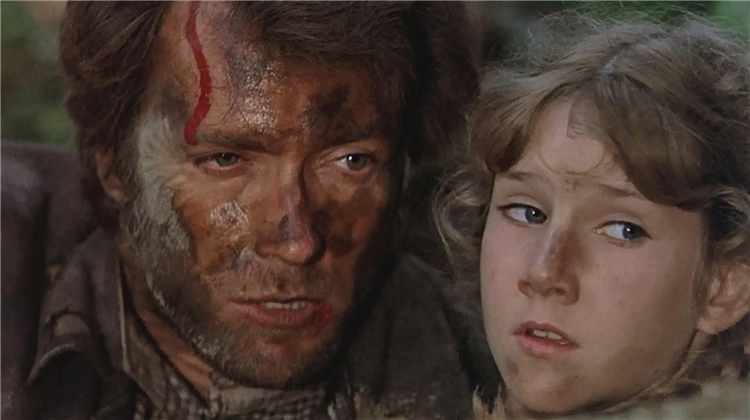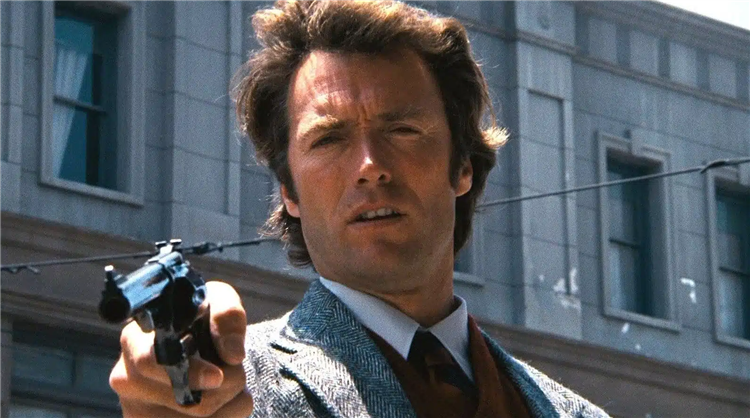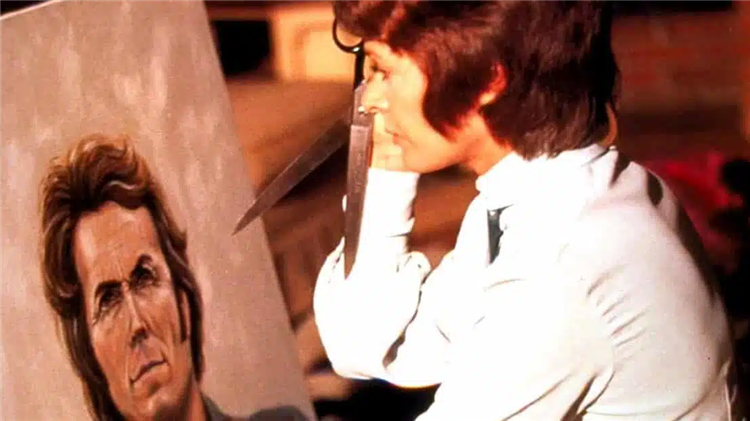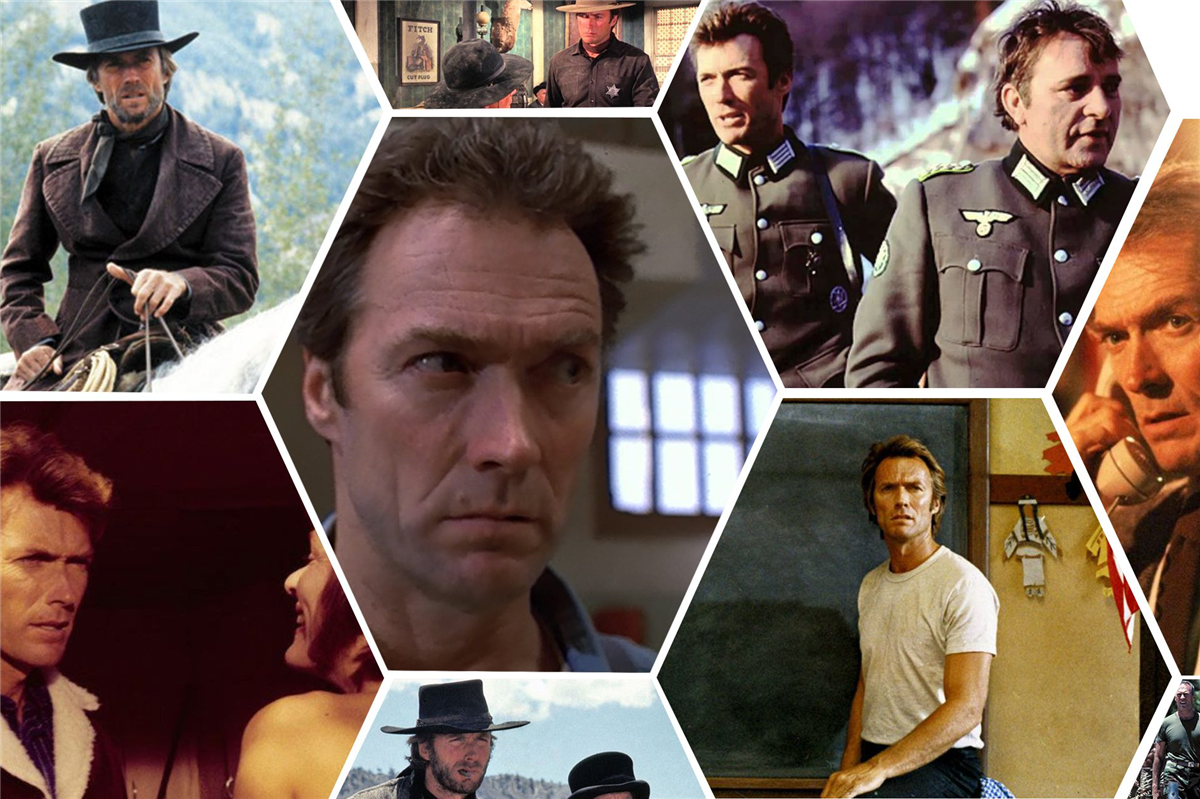Few actors have been able to command such an on-screen presence as Clint Eastwood. In a career spanning six decades, the 91-year-old actor has achieved a revered status in Hollywood as one of the most well-known celebrities both in front of and behind the camera.
Eastwood began his career initially as a star of the hit TV show, Rawhide, but his early forays into film were largely unsuccessful. In 1964, he traveled to Italy to work with director Sergio Leone on a new type of Western breaking off stylistically and conventionally from the earlier Western films of the ’40s and ’50s. The result, A Fistful of Dollars, created what would become known as the Spaghetti Western—one of the most famous subgenres in all of cinema—and established the tall, lean, steely-eyed Eastwood as an international star.
The Iconic Clint Eastwood
Over the next few decades, Eastwood became one of America’s most successful actors, starring in a string of Westerns, crime thrillers, and war films that earned him a distinguished place in popular culture as a personification of modern masculinity, before turning his attention to directing and starring in his own films.
Today, Eastwood is seen as one of the most iconic American actors of all time. His work on well-known films like The Good, the Bad, and the Ugly and High Plains Drifter created an unmatched onscreen personality that made him as synonymous with the Western genre as John Wayne. Even at his late age, Eastwood seems to show no signs of slowing down, directing Academy Award-nominated films like American Sniper, Sully, and Richard Jewell.
With Eastwood’s newest film, Cry Macho, having been recently released on HBO Max and in theaters, we thought we’d take a look back at the actor-director’s career so far, looking at some of his best films, and providing information about where they are currently streaming.
1. The Good, the Bad, and the Ugly

A very serious case could be made that any one of the Man with No Name Trilogy entries could have earned a spot on this list, but ultimately, you can’t beat the trilogy’s third and final installment, The Good, the Bad, and the Ugly. Director Sergio Leone and Clint Eastwood’s third entry in the Dollars movies finds the Man with No Name (this time around referred to as “Blondie”) reluctantly teaming up with a Mexican bandit (Eli Wallach) to find a cache of gold coins as the Civil War rages around them.
One of the most iconic Westerns ever made—and almost certainly the quintessential Spaghetti Western film by Leone, the man essentially responsible for creating the genre—The Good, the Bad, and the Ugly has so many strong points, it’s difficult to know where to start. The now-classic soundtrack by Ennio Morricone gave us one of the most easily recognizable theme songs ever, and the visuals and sweeping cinematography will leave you immersed and in awe of whatever’s happening on screen.
A person could argue that Wallach steals the show in this movie as the comically oafish but generally good-hearted partner to Eastwood’s Blondie, but however you view it, you can’t deny this movie was a fantastic film that marked the last collaboration between Eastwood and Leone, the man who had essentially made the actor a household name.
Streaming on HBO Max
2. The Beguiled

Easily the strangest movie ever associated with Clint Eastwood is this 1971 adaptation of Thomas P. Cullinan’s novel, The Beguiled. From regular Eastwood director Don Siegel (who Eastwood had previously worked within Coogan’s Bluff and Two Mules for Sister Sara) comes this Southern Gothic story about a wounded Union soldier taken in by an all-female boarding school in Mississippi during the Civil War.
Not wanting to be handed over as a prisoner to the enemy, the soldier seduces and manipulates pretty much every woman in the school—teachers and students alike—causing a rivalry and jealousy among everyone at the school that turns increasingly more dangerous for all parties involved. Out of all the movies in Eastwood’s lengthy filmography, his role as the deceitful, manipulative, predatory Union infantryman is far and away from his most distinct departure from the usually quiet, reserved heroes he’s known for.
Downright despicable, the more of him you see in The Beguiled, the more you grow to hate him, just like all his female counterparts in the film. In a career that spans 60 years and over 70 movies, The Beguiled remains the most out-of-character role in Eastwood’s lengthy filmography. For that alone, it’s almost certainly worth your time watching.
Streaming on Hulu (premium subscription required)
3. Dirty Harry

Aside from the Man with the No Name in Leone’s Dollars Trilogy, Eastwood has few characters as closely associated with his name as Harry Callahan, the cantankerous protagonist of the Dirty Harry franchise who is more of a gut-sure vigilante than a law-abiding police officer of the courts.
The first film in a series that would include four sequels, Dirty Harry follows the eponymous police inspector investigating a Zodiac Killer-style serial killer in San Francisco, using any means necessary to catch the person responsible.
Director Don Siegel’s fourth collaboration with Eastwood, Dirty Harry was an overwhelming critical and financial success, with the film establishing many of the tropes and characteristics associated with later police drama films (similar to Eastwood and Leone’s achievement in essentially creating the Spaghetti Western). Not only that, but it formed another part of Eastwood’s onscreen persona.
Building off the quiet, reserved type of personality that he’d given the Man with No Name, Dirty Harry brought in a much more ornery side to Eastwood’s archetypal character, a trait that Eastwood would rely on over the rest of his career, alternatively playing the man of few words in his Westerns, and the perpetually angry, tough-as-nails character seen in later films like Heartbreak Ridge, Million Dollar Baby, and Gran Torino.
Streaming on HBO Max
4. Play Misty for Me

After years of appearing in the films of talented filmmakers like Sergio Leone and Don Siegel, Eastwood decided to set out on his own directing career in 1971. The effort—a psychological thriller starring Eastwood and Jessica Walters—was a huge success, giving Eastwood the confidence to pursue his directorial career over the next four decades. Play Misty for Me follows a radio DJ (Eastwood) who has a short-lived romantic affair with a passionate, overzealous fan of his (Walters).
After the relationship sours, the DJ tries to break off the relationship, only for her to grow increasingly attached to him to the point of murder. A Hitchcockian thriller, Play Misty for Me was—like The Beguiled before it—another interesting entry in Eastwood’s filmography. Whereas Eastwood had built his entire onscreen identity as the stone-faced protagonist totally in control of the situation—one the villain doesn’t stand a chance in hell against—in Play Misty for Me, he’s a hapless victim who appears genuinely afraid and unsure of what to do with this fan whose admiration grows to pure obsession.
It was an interesting spin for Eastwood to take in his career and one that resulted in a genuinely good thriller. I could also spend an entire paragraph gushing about how great Walters was in her first major film role, but since this is Clint Eastwood-centric list, I’ll just mention briefly how fantastic she is in it.
Not currently streaming, but available to rent on Prime Video
5. Thunderbolt and Lightfoot

Clint Eastwood did a decent amount of mismatched buddy cop movies in his career—most of the Dirty Harry films and The Rookie, among them—that had some slight comedic moments, but none of them were as genuinely funny as this highly underrated 1974 comedy crime film that saw Eastwood teaming with then-rising star Jeff Bridges.
Filmmaker Michael Cimino’s (The Deer Hunter) debut work, Thunderbolt and Lightfoot features a pair of hopelessly mismatched but very capable criminals attempting to pull off one last bank robbery. Casting then-middle aged Eastwood as the older, more professional bank robber and having him team up with Bridges’ shaggy-haired, immature young thief was a stroke of genius, and made for some genuinely great onscreen chemistry between the two actors, creating plenty of laugh-out-loud funny moments and also more than a few heartfelt ones as well.
While Bridges himself may have stolen the show with this film (he was nominated for Best Supporting Actor at the Oscars for his role in this movie), Thunderbolt and Lightfoot nonetheless boasts a strong performance from Eastwood and character actors like George Kennedy and a hilarious Geoffrey Lewis as his clueless sidekick. It’s an entertaining movie that might not have the same exposure or popularity as Eastwood’s other well-known films, but it certainly should.
Streaming on Pluto TV
6. The Outlaw Josey Wales
Nestled somewhere in Clint Eastwood’s numerous Westerns is his highly enjoyable revisionist work, The Outlaw Josey Wales. Like many films in his career, especially in his early days as a filmmaker, Eastwood both starred in and directed this 1976 anti-war project, also featuring his future partner and frequent collaborator Sondra Locke, and extremely underrated actors Chief Dan George, Bill McKinney, and John Vernon.
In the film, Eastwood plays a peaceful farmer turned gunslinger who joins a band of guerrillas after his family is killed by pro-Union militants during the Civil War. When the war ends and the Confederacy surrenders, Wales flees to Texas, picking up several individuals along the way, all the while being hunted by the same men who killed his family.
Written by equally impressive filmmaker Philip Kaufman (Invasion of the Body Snatchers, The Right Stuff), Josey Wales brings a lot more heart and emotion to the typically aloof Eastwood character, with a portrayal showing the complexities of a man who wants to move on from his current life of violence but unable to do so fully.
Critically praised upon its initial release, the movie was widely acclaimed for its performances, soundtrack (which received an Oscar nomination), and its non-stereotypical treatment of Native American culture. Years later, famed filmmaker Orson Welles reappraised the film, naming it a Western on par with the classics of the 1940s and ’50s directed by John Ford and Howard Hawks.
Streaming on Netflix
7. Escape From Alcatraz
In 1979, Eastwood once again worked with frequent collaborator Don Siegel for what would be their fifth and final film together. Adapted from the 1963 nonfiction book of the same name, Escape from Alcatraz tells the highly dramatized story of three inmates (Eastwood, Fred Ward, and Jack Thibeau) who manage to become the only prisoners to ever escape from the maximum-security prison on Alcatraz Island.
With Eastwood playing Frank Marshall, a veteran bank robber, expert escape artist, and the architect of the trio’s escape plan, Escape from Alcatraz is basically Eastwood at his best, returning to the far quieter type of character he’d played in Leone’s Spaghetti Westerns, relying instead on stony silences and his signature piercing green-eyed glare to communicate most of his character’s thoughts.
An interesting enough prison film, the movie also has one of the tensest endings featuring the characters’ escape from Alcatraz, one that will have you holding your breath and gripping your chair as you watch the three desperately trying to avoid detection.
Streaming on Hulu
8. Unforgiven

One of the most highly-ranked Westerns of all time, and almost definitely the best to come out of Hollywood in the past 30 years, Unforgiven was meant to put the final nail in the genre’s coffin. After a sharp decline in popularity since the Westerns’ golden age in the ’40s and ’50s, Eastwood planned to launch a film that definitively ended the genre as everyone knew it, resulting in one of the most ambitious and hard-hitting Westerns ever made.
Unforgiven tells the story of a notorious reformed gunfighter William Munny (Eastwood), struggling to earn enough as a farmer to support his children. When an aspiring young gunslinger approaches him about one last job killing two cowboys who mutilated a prostitute, Munny reluctantly agrees, joining his former riding partner (Morgan Freeman) and coming at odds with a local sheriff (Gene Hackman) trying to keep the peace at all costs.
A very dark, depressing movie, Unforgiven explores the thematic violence and revenge found in nearly every Western movie but on a much more realistic scale, featuring characters who blur the line between hero and villain, and instead act morally somewhere in between.
At the 65th Academy Awards, the film won numerous top prizes, including Best Picture, Best Director (Eastwood), and Best Supporting Actor (Hackman). It would also serve as Eastwood’s final role in the genre that had established him as a star, and is now considered the finest American-made Western since The Searchers.
Streaming on HBO Max
9. The Bridges of Madison County
Eastwood’s career has been mostly defined by action-based Westerns, thrillers, or war movies, especially within the first three decades of his career. After his parting letter to the Westerns that he’d built his early career off of in Unforgiven, Eastwood’s later career focused more heavily on dramatic films, such as his critically-acclaimed 1995 romance film, The Bridges of Madison County. Directed by and starring Eastwood and based on the best-selling novella of the same name, The Bridges of Madison County revolves around a photographer (Eastwood) and a housewife (Meryl Streep) who meet in the 1960s’ Iowa countryside and begin a short-lived but passionate love affair.
Before this film, Eastwood wasn’t exactly known for his romantic roles, but The Bridges of Madison County allowed him to explore a more tender, emotional performance than any role he had previously taken on. It was a much more dramatic project than any Eastwood had worked on before, and one that was warmly received by critics (for her role, Streep received a nomination for Best Actress).
It also hinted at a new phase in Eastwood’s later career as a director, one who was more focused on dramatic, grounded stories that revolved around average people in realistic scenarios, rather than the unstoppable, gun-toting tough guys he had played for so many years.
Streaming on Hulu (premium subscription required)
10. Million Dollar Baby
If Eastwood’s directorial and acting career in the ’90s and 2000s’ were marked by increased sentimentality, Million Dollar Baby is by far his most dramatic and heartfelt film from that period. Directed by and starring Eastwood, Million Dollar Baby tells the story of an amateur aspiring boxer (Hilary Swank) who wishes to become a professional.
To achieve her dreams, she enlists the help of an older, ill-tempered boxing trainer (Eastwood), who appears reluctant at first, but eventually warms to her and agrees to help, forming a strong father-daughter-like relationship in the process.
While that summary might make this film out to be some sort of Rocky-like sports drama all about an underdog winning in the end, Million Dollar Baby is anything but—just when you think you know where the movie is going, a midpoint plot twist completely curtails any expectations you have regarding the story’s direction.
By far the saddest film in Eastwood’s filmography, Million Dollar Baby became one of his most successful movies, earning seven Oscar nominations and winning four more (Best Picture, Best Director, Best Actress [Swank], and Best Supporting Actor [Morgan Freeman, who appears as an elderly former boxer and Eastwood’s best friend and employee in the film]). For those who’ve never seen this movie, we’re warning you right now: be ready to cry, and be ready to cry a lot.
Streaming on HBO Max
11. Gran Torino

The older Eastwood gets, the nastier his onscreen roles become. In his 2008 film (which he also directed), Gran Torino, Eastwood plays Walt Kowalski, a veteran of the Korean War and probably the meanest elderly neighbor ever. Eastwood’s most offensive, racist, and ill-tempered character to date (yes, even more so than Harry Callahan), Walt despises pretty much everyone in his Highland Park suburban neighborhood, which has become increasingly ethnically diverse, including a sudden influx in Hmong Americans, much to Walt’s chagrin.
When one of Walt’s neighbors—a young Hmong teenager (Bee Vang)—is pressured into trying to steal Walt’s priceless 1972 Gran Torino, Walt slowly forms a bond with the teenager and his family, helping the impressionable young man find some direction in life, and allowing Walt to grow past his bigotry and hateful worldview. It might seem an overly sentimental or melodramatic film from that description, but don’t let that fool you: Gran Torino is just as hard-edged as some of Eastwood’s earlier films, featuring a protagonist with a violent past and his struggles to move past his former life.
In a career defined by war films and Westerns, Gran Torino is a touchingly simple film very much grounded in real life, and presents one of Eastwood’s most nuanced, complex characters yet, someone who is equally unlikable, sympathetic, wholesome, good-natured, and straight-up terrifying throughout the film.
Streaming on HBO Max
Clint Eastwood: Still Feeling Lucky
There’s a reason why Clint Eastwood has been and continues to be one of the most distinct and easily recognizable names in all of American film. Over the course of 60 years, he has earned a distinct place as a cultural icon of his day. Whether he’s chomping on a cigarillo and wearing a poncho, dangling a mammoth .44 Magnum by his side, or threatening onscreen antagonists with any number of his oft-quoted famous lines (“Do you feel lucky, punk?”) in that growling low voice of his, few actors have such a striking onscreen presence as Eastwood.
Today, the 91-year-old still seems virtually at the top of his game, directing and starring in movies like his most recent Cry Macho just as he had in the ’70s. We have no idea what the future holds for Eastwood, but at the rate that he’s going, we’re sure he’s not going anywhere any time soon.
